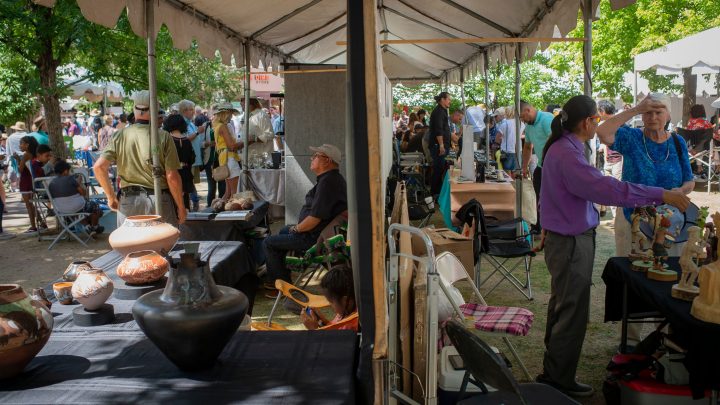
For Indigenous artists, pricing is a tricky proposition
For Indigenous artists, pricing is a tricky proposition

Over the past few years, as the cost of everything from wholesale goods to labor has gone up, small businesses in particular have faced a tough question: How long can they pass those rising costs along before they start to alienate consumers?
It’s an especially tough question for small business owners for whom pricing has always been tricky: makers of high-end Indigenous art. At this year’s Santa Fe Indian Market, which draws roughly 1,200 of the very best Native artists and craftspeople from all over North America, rising input costs were on a lot of vendors’ minds.
“It’s getting harder and harder to factor in that inflation,” said John Murie, a Chippewa and Cree beadwork artist from the Rocky Boy Reservation in Montana known for his beaded moccasins.
Murie lucked out this year with a booth right on Santa Fe’s historic plaza where there’s plenty of foot traffic. By Sunday morning — the second and final day of Indian Market — he’d made a couple of big sales.
“I did pretty good. I’ve sold about half my inventory. I have a little bit left for today. Hopefully, I will sell a little bit more,” Murie said, including a small green and white beaded vest waiting for some very stylish kid to take it home.
“The vest took quite a while to do,” he said. “It’s fully beaded on the front and the back, so that’s $3,200 with the tie.”
That’s more than Murie would have charged two years ago, before he said the price of beads and smoked animal hides rose by as much as 30%. But it doesn’t fully account for his rising costs. He said he can only raise his prices so many times before his sales start to slow down.
A few rows of booths over, Christy Ruby is also figuring out how to account for more expensive inputs.
“Well, when I heard that ammo was going up, I bought probably everything I could use for the next ten years,” she said.
Ruby is Tlingit from Ketchikan, Alaska. She hunts seals, sea otters and other animals herself, tans the furs, then sews them into winter wear like vests, scarves and her signature fingerless mittens.
“They are luxurious, but you can also use them to shovel your driveway and muck out horse stalls if you want,” Ruby said.
She uses a pricing formula that accounts for the rising cost of ammunition and travel and boat fuel: Cost of goods, cost of materials, cost of time, multiplied by three. Lately, that shakes out to around $600 for a sealskin bomber hat.
But that equation doesn’t take into account the generations of innovation and traditional knowledge that go into just about everything for sale at Indian Market.

“It’s a collection here of all priceless pieces. Maybe the outside world hasn’t caught on yet, but all of us on the inside world know that,” said Elizabeth James Perry, an Aquinnah Wampanoag artist from Martha’s Vineyard. Her wampum jewelry ranges in price from a pair of simple earrings for as little as $40 to an intricate pendant for close to $800.
Perry said many of the artists here can’t charge what their work is truly worth, because their work is marginalized in the world of fine art. Buyers and collectors expect even very high-end Native art to be affordable, she said. And that means Native artists’ labor gets undervalued.
“If we got paid per hour, it would be like a nickel an hour,” said Karenlyne Hill, an Onondaga artist from New York.
“This took me about six weeks,” Hill said, gesturing to a red velvet hat on display in her booth. It’s stunning, with intricate yellow raised beadwork in the Haudenosaunee tradition. She’s hoping to get just $400 for it.
“To tell you the truth, I’d put it at $800 if I thought I could sell it,” she said.
Hill has been coming to Indian Market for a decade now, and for her, it’s not all about moving inventory and making a profit. She said it’s a chance to rub shoulders with some of the most talented artists in the world and for her work to be in conversation with theirs.
“To me, [Indian Market] is the best of the best. And I’m sitting here,” she said.
If she gets home to New York with a lighter suitcase and her travel costs covered, Hill said the trip to Santa Fe will have been worth it.
There’s a lot happening in the world. Through it all, Marketplace is here for you.
You rely on Marketplace to break down the world’s events and tell you how it affects you in a fact-based, approachable way. We rely on your financial support to keep making that possible.
Your donation today powers the independent journalism that you rely on. For just $5/month, you can help sustain Marketplace so we can keep reporting on the things that matter to you.


















